Even the most seasoned plant parent can struggle with succulent pests and diseases that can harm plants. In this guide, we’ll cover common succulent pests and diseases, how to identify them, and the treatments to keep your succulents healthy.
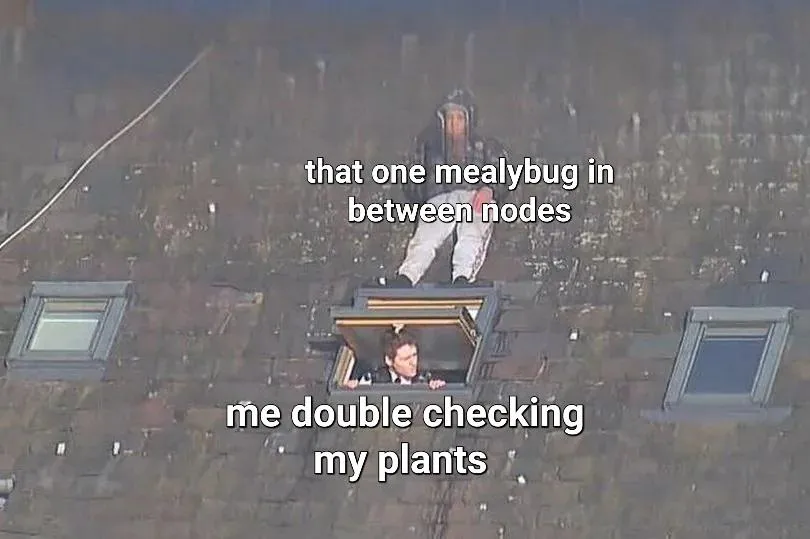
Dig in!
Common Succulent Pests
Succulents can be vulnerable to a variety of pests that can damage their leaves, stems, and roots. Here are some common pests to look out for:
As An Amazon Associate I earn From Qualifying Purchases.
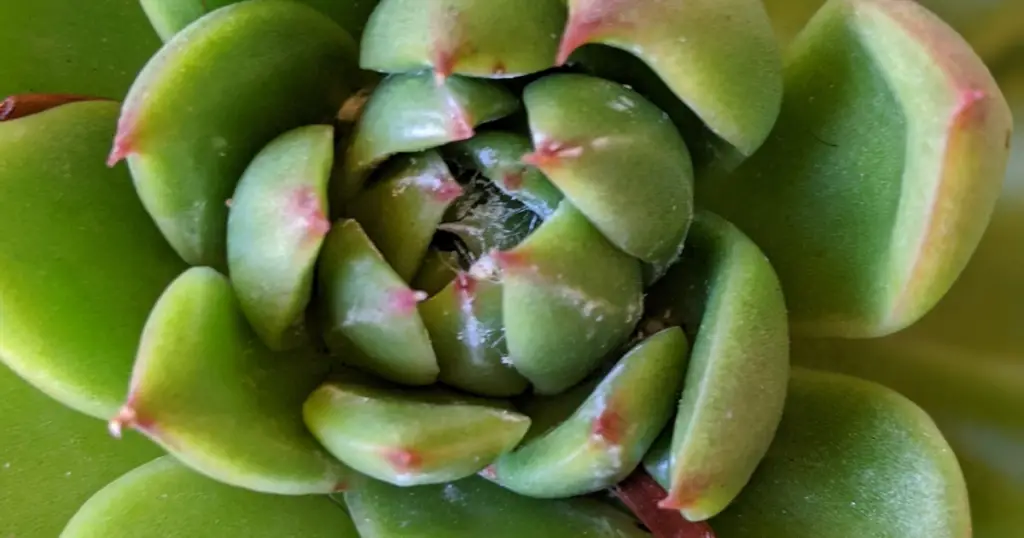
Mealybugs
Mealybugs are tiny, soft-bodied insects that are covered with a white, powdery wax that resembles cotton.
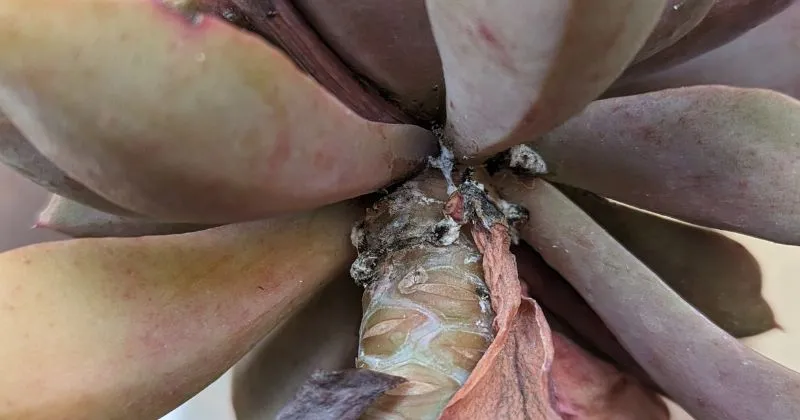
How They Damage Succulents
They feed on the sap of succulent plants, draining the plant’s energy and causing stunted growth, yellowing leaves, and a weakened immune system. They also excrete a sugary substance known as honeydew, which can attract other pests like ants and promote the growth of sooty mold.
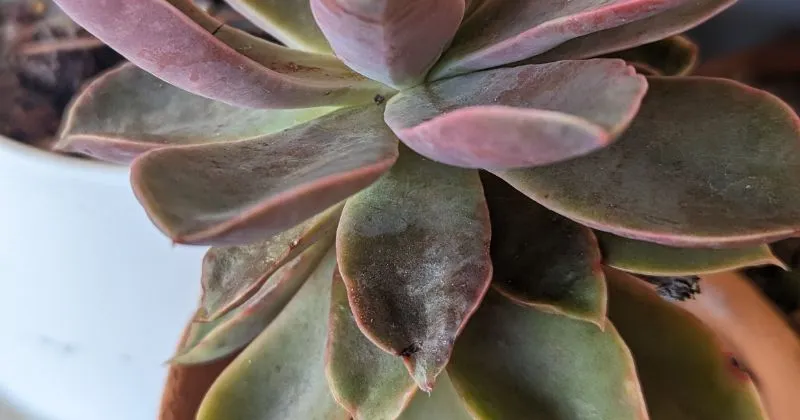
How to Prevent Mealy Bugs
To prevent mealybugs from infesting succulents, it is important to regularly inspect new plants before introducing them to your collection. Mealybugs can also be transported on contaminated tools and pots, so it is important to clean and sanitize these items before using them on other succulents.
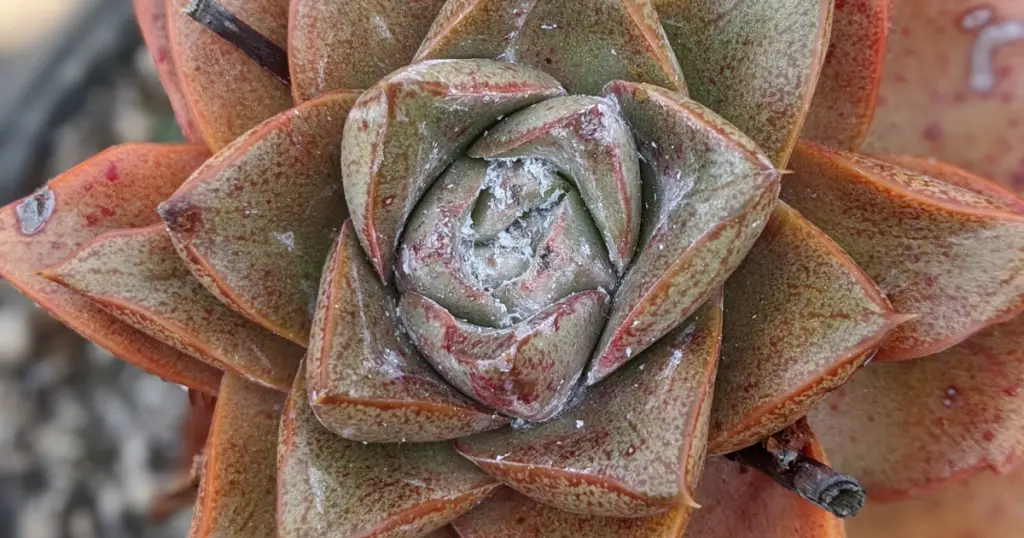
How to Kill Mealybugs
If you notice mealybugs on your succulents, you can remove them by dabbing them with a cotton swab dipped in rubbing alcohol. As another mealybug treatment, you can also use a mixture of dish soap and water to suffocate them. For severe pest infestations, it may be necessary to use a systemic insecticide or introduce beneficial insects like ladybugs or lacewings to help control the population.
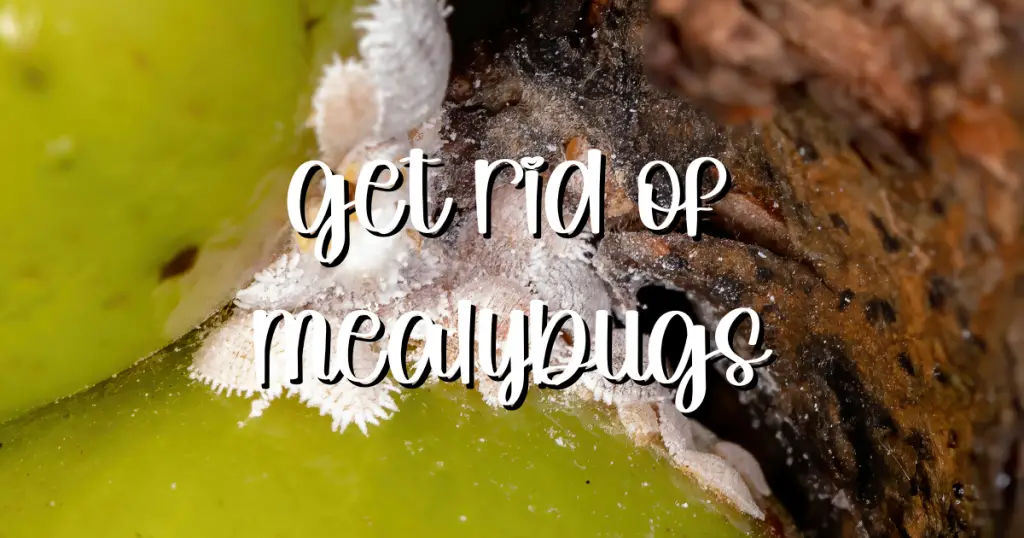
Scale Insects
Scale insects are small, immobile pests that feed on the sap of plants, including succulents.
What Scale Insects Look Like
They can be identified by their hard, protective shells, which can range in color from white to brown or black.

How Scale Kills Succulents
Scale insects damage succulents by weakening the plant and causing yellowing or dropping of leaves. They also secrete a sticky substance called honeydew, which can lead to the growth of sooty mold.
How to Prevent Scale
Prevention of scale insects involves regular inspection of succulents for signs of infestation, as well as keeping plants healthy through proper watering, fertilization, and pruning. In addition, maintaining good air circulation can help prevent infestations.
How to Kill Scale Insects
Treatment of scale insects involves physical removal of the pests with a soft-bristled brush or by wiping the succulent down with a damp cloth. For larger infestations, insecticidal soaps or oils can be used.
How Insecticides Work Against Scale
These products work by suffocating the insects or disrupting their outer protective layer. It is important to follow the manufacturer’s instructions carefully and to avoid spraying in hot or sunny conditions, which can damage the succulent.
Thrips
Thrips are small, slender insects that have fringed wings and feed by piercing and sucking the juices from succulents. They can be difficult to detect because of their small size, and their feeding can cause a range of problems for succulent plants.
How Thrips Damage Succulents
Thrips can cause leaf distortion and discoloration, stunted growth, and black, shiny excrement on the leaves. In severe cases, thrips can cause leaf drop and succulent death.
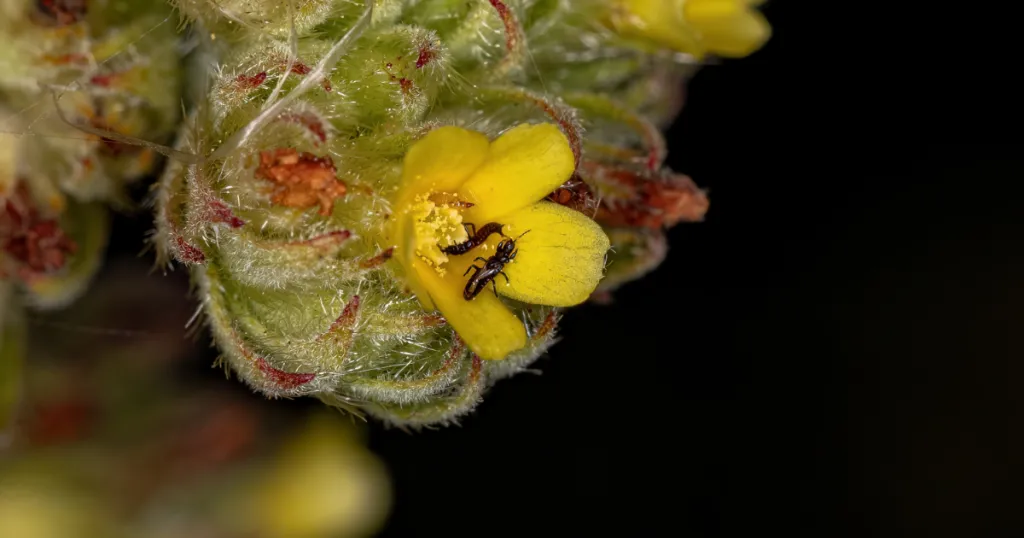
How to Prevent and Kill Thrips
Regularly inspecting your succulents for signs of thrips is also a good way to catch and treat infestations early. Remove any affected leaves or succulents and dispose of them properly.
Treatments for thrips infestations include using insecticidal soap or neem oil sprays, which can be effective against thrips. Beneficial insects like predatory mites and lacewings can also help control thrips populations.
Ants
Ants are not necessarily harmful to succulents in and of themselves, but they can bring other pests like aphids, mealybugs, and scale insects to the succulent. Ants feed on the sweet, sticky honeydew produced by these pests, so their presence can indicate a larger pest problem. Any time I see ants, I know there’s a mealybug infestation nearby.
Fungus Gnats
Fungus gnats are small black flies that can often be seen hovering around the soil of potted plants , including succulents. They are attracted to moist soil and organic matter, and their larvae feed on the roots of the succulents, which can cause damage and make them more susceptible to other diseases.
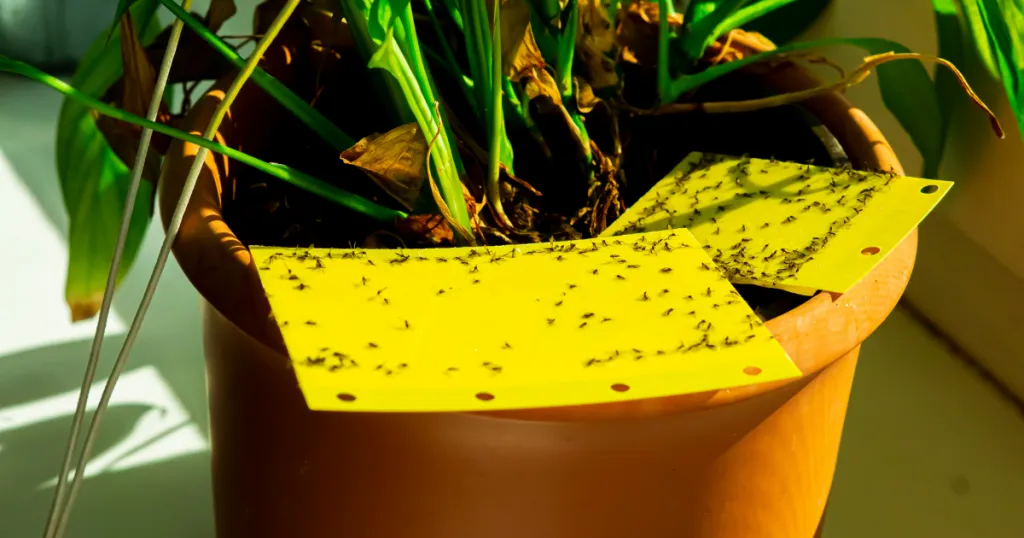
How to Prevent Fungus Gnats
To prevent fungus gnats, make sure to use well-draining soil and avoid overwatering. You can also use a layer of sand on top of the soil to help prevent the gnats from laying their eggs.

Another option (and my favorite) is to use a biological control such as Bacillus thuringiensis israelensis (BTI), like Mosquito Bits, which is a naturally occurring soil bacteria that kills the larvae of fungus gnats. You can also use insecticides such as neem oil or spinosad, which are effective against both the adult gnats and the larvae.
Agave Snout-Nosed Weevil
The agave snout-nosed weevil is a type of beetle that feeds on Agave, which includes many species of succulents.
How the Agave Snout-Nosed Weevil Kills Agave
This giant agave bug feeds on the leaves, while the larvae bore into the succulent’s stem and cause significant damage, eventually leading to plant death.
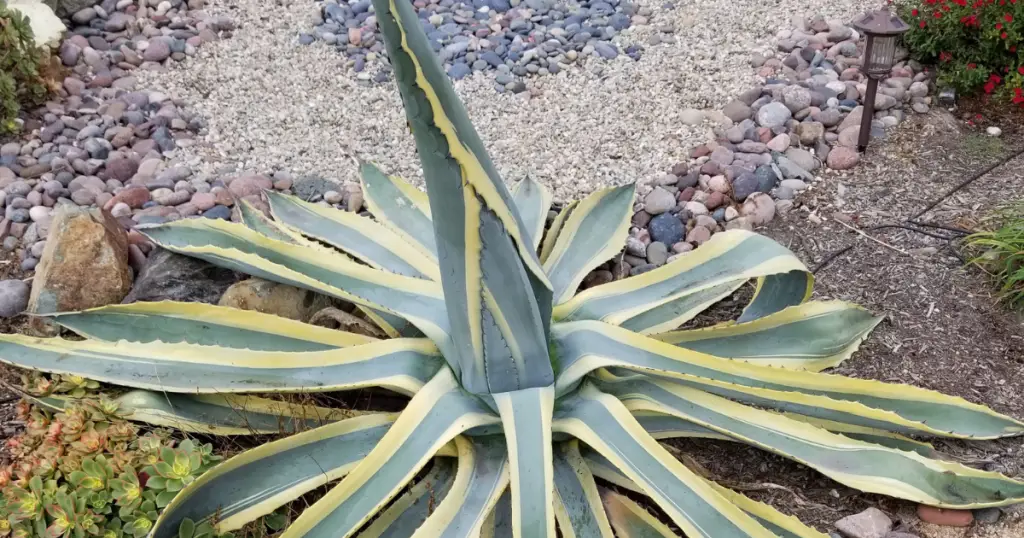
How to Prevent the Agave Snout-Nosed Weevil
Prevention is the most effective method for dealing with the agave snout-nosed weevil. When you buy new plants, make sure to check them for signs of damage, especially around the stem and roots. If you have an infected plant, remove it from the rest of your collection to prevent the giant agave bug from spreading. Keep a clean growing environment. This includes removing dead leaves and debris from the soil, cleaning up fallen flowers, and regularly removing weeds from your garden.
How to Kill the Agave Snout-Nosed Weevil
Treatment for the agave snout-nosed weevil is not always effective, as the damage may be too extensive to save the succulent. If you catch an infestation early, you can try physically removing the larvae from the succulent. Systemic insecticides can also be used to treat and prevent infestations of the agave snout-nosed weevil. Remove any damaged or rotting parts of the plant and repot it in fresh soil.
Aloe Mites
Aloe mites are tiny, microscopic pests that can infest and damage Aloe plants. They cause yellowing, cancer-like deformation, and stunted growth.
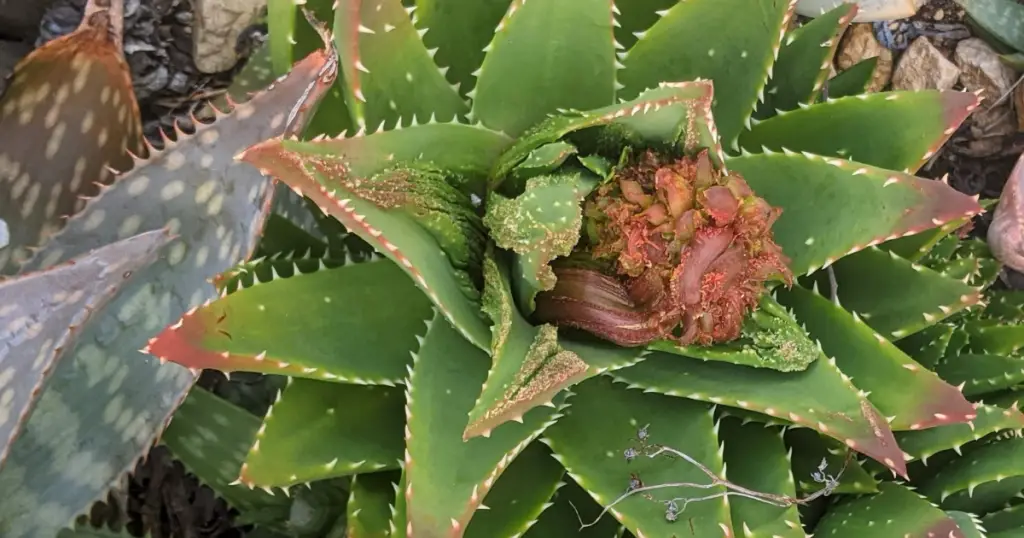
Aloe mites are difficult to see without magnification, and often go undetected until they have caused significant damage. They are most commonly spread by contact with infected plants or through infested soil or tools.

How to Prevent Aloe Mites
Prevention of aloe mites includes keeping plants healthy and avoiding overcrowding, as the mites tend to spread more easily in stressed or weakened plants. Quarantining new succulents and regularly cleaning tools and equipment can also help prevent the spread of the mites.

How to Treat Aloe Mites
Once you can see the damage that aloe mites have created, it is far too late to save that plant. You have to throw away the affected aloe, any of its pups that are still attached and any other aloe near it. Put them in a sealed plastic bag before tossing them in the garbage to prevent the spread.
Agave Mites
Agave mite is a tiny insect that has been causing problems for many Agave plants. Some Agave plants are more susceptible to infestations than others, and the mite can interfere with their reproduction and eventually kill the plants.
How Agave Mites Kill Succulents
Agave mite damage is not easy to recognize, and it can take months to develop. If you notice any lesions or grease stains on the Agave leaves, it is likely due to the mites.
How to Treat and Prevent Agave Mites
If you have an Agave plant with mite damage, it is important to treat it quickly to prevent the mites from spreading to other plants in your collection. Treat all plants in the area, even if they are not showing symptoms, as they could be infected.
Treatment involves using special miticides and spraying the plants thoroughly, but it can be expensive and time-consuming. It may take up to a year for broad infestations to be fully treated, and you must continue to monitor your plants to make sure the mites do not return.
Spider Mites
Spider mites are tiny arachnids that feed on the sap of succulents. They are common pests in succulent gardens and can cause significant damage to the succulents if left untreated. These pests are typically found on the undersides of leaves and spin fine webs.
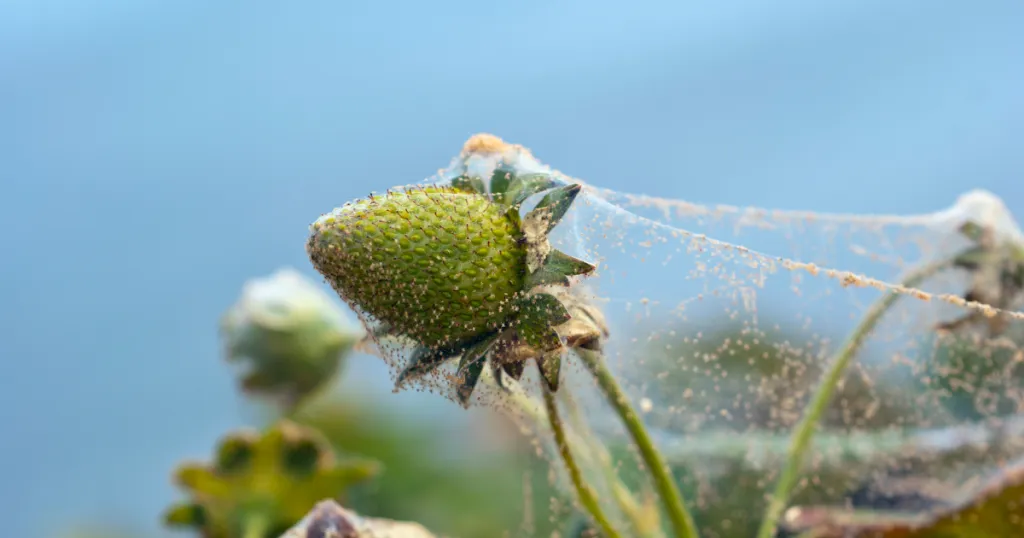
Spider mites suck the sap from the leaves of succulents, causing them to turn yellow, dry up, and drop prematurely. They also leave behind fine webs, which can make the succulents look unsightly. These pests reproduce quickly, and a heavy infestation can cause stunted growth, distorted leaves, and even death.
Keep your succulents well-watered and in a location with good air circulation. Regularly inspect your succulents for signs of infestation, especially on the undersides of leaves. If you catch an infestation early, you can usually remove the affected leaves and spray the succulent with a stream of water to dislodge the mites.
If the infestation is more severe, you may need to use a miticide. You may also want to consider introducing beneficial insects, such as ladybugs, which are natural predators of spider mites.
Common Succulent Diseases
In addition to pests, succulents can also fall victim to diseases that can impact their growth and appearance. Here are some common succulent diseases to look out for:
Root Rot
Root rot is a fungal disease that can be caused by overwatering or poor drainage. It can cause the roots of the succulent to rot, leading to wilting, yellowing, and decay.
How to Treat Root Rot
To treat root rot, remove the plant from the soil and cut off any affected roots. Repot the plant in fresh, well-draining soil and reduce watering to prevent further damage.
To find out more on root rot, visit: Root Rot in Succulents: How to Identify and Treat the Problem
Powdery Mildew
Powdery mildew is a fungal disease that appears as a white, powdery substance on succulent leaves, stems, and flowers.
Powdery mildew thrives in humid environments and spreads through the air, so it’s essential to keep the growing environment dry and well-ventilated. High humidity and stagnant air can create the ideal conditions for powdery mildew to develop. As powdery mildew spreads, it can also affect the plant’s ability to absorb sunlight, leading to stunted growth and diminished flowering.
How to Prevent Powdery Mildew
How to Prevent Powdery Mildew
The best way to prevent powdery mildew is to provide proper ventilation and avoid over-watering. If you’re growing succulents indoors, consider using a dehumidifier to control humidity levels.
How to Get Rid of Powdery Mildew
If powdery mildew does occur, there are several treatments available. Some people prefer to use a homemade solution of 1 part milk to 9 parts water, which can be sprayed directly onto the affected areas. Other treatments include using a baking soda solution, neem oil, or a commercial fungicide.
Prune off any leaves, stems, or flowers that show signs of powdery mildew and dispose of them properly. Additionally, avoid composting any affected plant parts, as the disease can continue to spread even after the succulent is dead.
Bacterial Soft Rot
Bacterial soft rot is caused by bacteria that thrive in moist conditions, and is most common in plants that have been overwatered or are growing in soil that does not drain well.
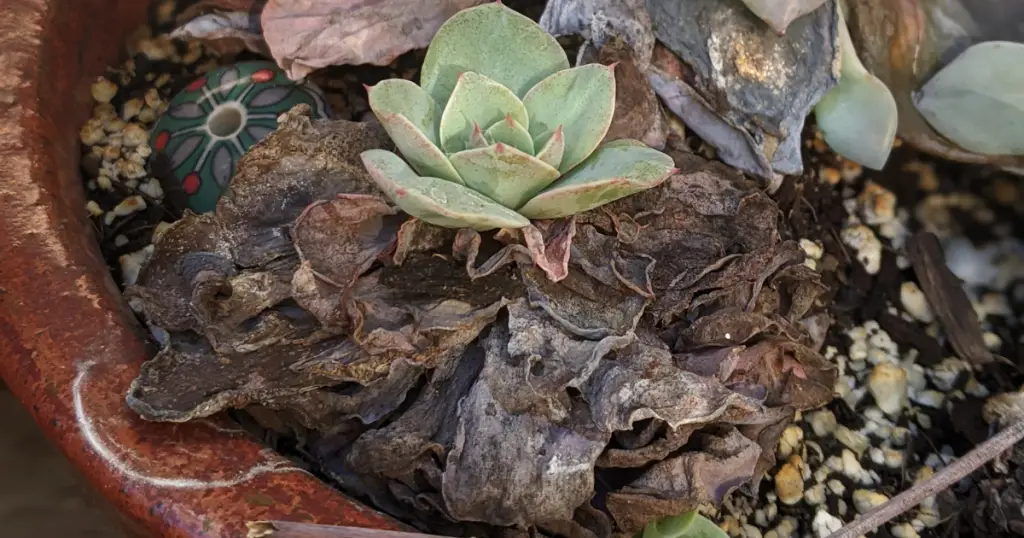
The symptoms of bacterial soft rot include a soft, mushy stem or leaves that may be discolored or have a foul odor. In advanced stages, the affected tissue may turn black and appear waterlogged. The bacteria can quickly spread to healthy tissue, and if left untreated, the succulent may die.
How to Prevent Bacterial Soft Rot
To prevent bacterial soft rot, it is important to ensure that your succulent plants are not overwatered and that they are growing in soil that is well-draining. Avoid getting water on the leaves or stem of the succulent, and make sure that any excess water is drained away.
Remove any affected parts of the succulent, including leaves, stems, or roots, and discard them in the trash. Do not compost or reuse any infected plant material.
How to Treat Bacterial Soft Rot
Treat the remaining succulent with a bactericidal solution, such as a copper fungicide or a solution of hydrogen peroxide and water. You may also need to adjust your watering schedule and improve drainage to prevent the disease from recurring.
Leaf Spot
Leaf spot is caused by a variety of fungi that thrive in moist environments and can spread quickly under the right conditions.
What Leaf Spot Looks Like
Symptoms of leaf spot on succulents include brown or black spots on the leaves, which can be circular or irregularly shaped. These spots may have a yellow or brown halo around them, and as the disease progresses, the leaves may become distorted or wilted.
How to Treat Leaf Spot
Treatment for leaf spot on succulents usually involves removing infected leaves and treating the succulent with a fungicide. Copper-based fungicides are effective against leaf spot, and they can be found at most garden centers or online.
If leaf spot has spread to multiple plants in your collection, you may need to isolate the infected plants to prevent the disease from spreading.
Black Sooty Mold
If you have noticed a black, sooty substance on the leaves and stems of your succulent plants, it’s likely that they have been affected by a fungus called sooty mold.
What Black Sooty Mold Looks Like
Sooty mold is a type of fungus that commonly affects succulent plants and appears as a black, powdery or sticky substance on the leaves and stems, hindering their growth and affecting their overall appearance. It can be unsightly and may indicate that your plant is suffering from an underlying issue.
How to Treat Black Sooty Mold
Fortunately, there are several ways to treat sooty mold and prevent it from spreading to other plants in your collection. The first step is to isolate the affected plant to prevent the fungus from spreading to other plants. Then, you can use a combination of methods to treat the mold and restore your plant’s health.
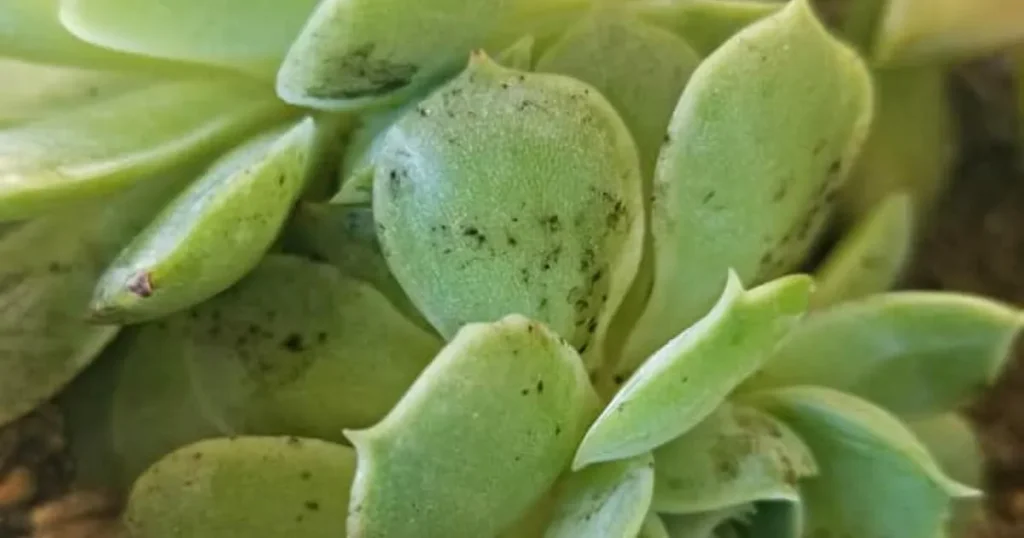
One of the most effective ways to treat sooty mold is to remove it physically by wiping it off with a soft cloth or brush. This will remove the mold and improve the plant’s appearance, but it’s important to keep in mind that wiping away the mold doesn’t address the underlying cause of the problem. To address the root cause, you need to identify and address the underlying issue that led to the mold growth.
For 9 other treatments for black sooty mold, check out: Black Sooty Mold: 10 Effective Ways to Treat it on Succulents
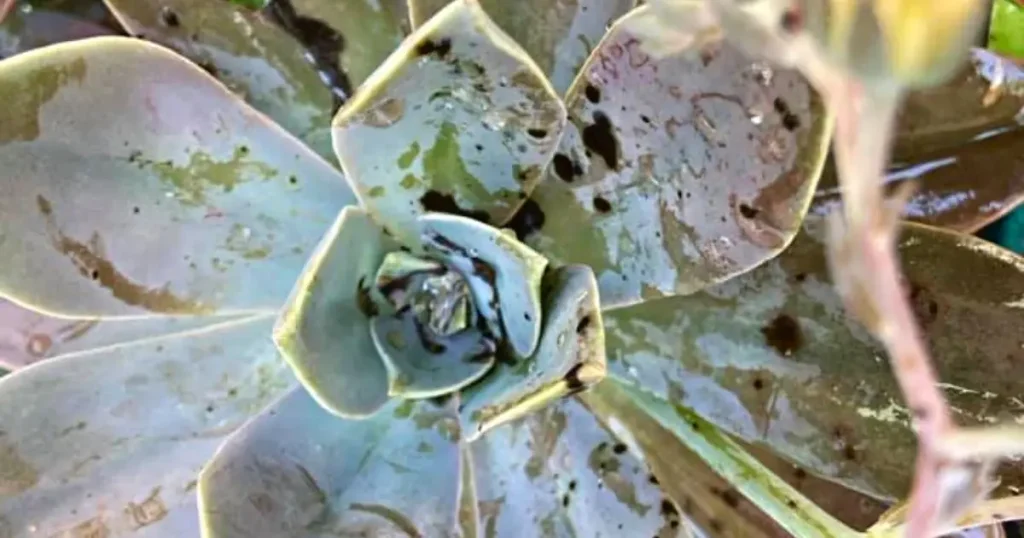
General Preventions and Treatments
Neem Oil
Neem oil is a natural plant-based oil that is derived from the seeds of the neem tree (Azadirachta indica), which is native to India and other parts of South Asia.
Neem oil is effective in treating and preventing a range of succulent pests and diseases, including aphids, spider mites, mealybugs, and scale insects. It can also be used to control fungal diseases such as powdery mildew, black spot, and rust.
How Neem Oil Works
Neem oil works by disrupting the feeding and reproductive behaviors of pests, as well as inhibiting the growth and development of fungi.
Neem oil is generally considered to be safe for use on plants and is approved for use in organic farming. Overuse or misuse of neem oil can cause harm to beneficial insects and pollinators, as well as damage to the succulent itself.
Does neem oil remove the farina from succulents?
Neem oil can also have an unintended effect on the farina, the powdery white substance that covers some succulents such as Echeveria.
If neem oil is applied directly to the farina, it can cause the powdery coating to dissolve or become discolored, which can result in the succulent losing its characteristic appearance. Therefore, it’s best to avoid spraying neem oil directly onto the leaves of succulents that have farina, or to dilute it significantly before applying.
If you need to treat a pest infestation on a succulent with farina, it’s better to use a targeted treatment such as insecticidal soap or rubbing alcohol on the affected areas, rather than spraying the entire plant with neem oil.
Insecticidal Soap
Insecticidal soap is a type of pesticide that is made from a solution of potassium salts of fatty acids. It is a contact insecticide that works by breaking down the protective coating on the surface of insects, causing them to dehydrate and die.
How Insecticidal Soap is Made
To make insecticidal soap, potassium hydroxide is reacted with natural plant oils, such as soybean oil, to create a soap-like substance. This substance is then diluted with water to create the final solution, which can be applied to plants with a spray bottle. It is effective against soft-bodied insects and their eggs. However, it is less effective against hard-bodied insects, such as scale insects and beetles.
Insecticidal soap is generally considered to be safe for use on plants, as it is a low-toxicity pesticide and breaks down quickly in the environment.
Bifenthrin
Bifenthrin is a synthetic pyrethroid insecticide that is used to control a wide range of insect pests. It is used in both agricultural and residential settings to control succulent pests.
How Bifenthrin Kills Pests
Bifenthrin works by disrupting the nervous system of succulent pests, causing paralysis and death. It is a contact insecticide, meaning it must come into direct contact with the insect to be effective. Bifenthrin is also a long-lasting insecticide, providing residual control for several weeks or even months after application.
Bifenthrin is available in a variety of formulations, including liquids, granules, and dusts, and can be applied using a variety of methods, such as sprays, foggers, and baits. It is considered to be relatively low in toxicity to humans and other mammals, but it can be harmful to beneficial insects such as bees and aquatic organisms.
Imidacloprid
Imidacloprid is a systemic insecticide that belongs to a class of chemicals called neonicotinoids. It is a highly effective insecticide that is used to control a wide range of succulent pests.
How Imidacloprid Works to Kill Pests
Imidacloprid works by interfering with the nervous system of insects, causing paralysis and death. It is a systemic insecticide, which means it is absorbed by the succulent and moves throughout its tissues, making the entire plant toxic to insects. When succulent pests, like mealybugs, feed on a plant treated with imidacloprid, it ingests the chemical and is killed.
Imidacloprid is available in a variety of formulations, including sprays, granules, and soil drenches, and can be used on a range of plants, including succulents. It is often used as a preventative measure to control succulent pests before they become established, but it can also be used to control existing infestations.
Be Careful With Imidacloprid
While imidacloprid is highly effective at controlling succulent pests, there has been concern about its impact on non-target organisms, such as bees and other pollinators. It is important to follow label instructions carefully when using imidacloprid and to use it only when necessary and in a responsible manner. It is also important to store and dispose of the chemical properly to avoid environmental contamination.
I use imidacloprid once or twice a season all over my yard to prevent any succulent pest infestations and I spot treat anything that comes up in between doing the yard. I’m careful not to apply it when there are any flowers present because I don’t want it killing any of the pollinators the flowers attract. If I have an active infestation, I’ll spray the whole plant and soil with a contact insecticide and then drench the soil with imidacloprid to get any residual bugs leftover.
I usually buy a jug of this once a year or so.
Diatomaceous Earth
Diatomaceous earth is a naturally occurring substance that is made from the fossilized remains of diatoms, which are a type of hard-shelled algae. It is a fine powder that is composed of silica, which has abrasive and absorbent properties.
To make diatomaceous earth, the fossilized remains of diatoms are mined from deposits in the earth and then ground into a fine powder. The powder is then treated to remove any impurities and can be used for a variety of purposes, including as a pesticide.
Diatomaceous earth is often used to control a range of succulent pests, including aphids, thrips, and spider mites. When insects come into contact with the diatomaceous earth, the abrasive particles pierce their exoskeletons, causing them to dehydrate and die.
Diatomaceous earth is also effective at controlling slugs, snails, and other soft-bodied succulent pests by absorbing the protective mucous layer that covers their bodies, leading to dehydration and death. I like using it when there are ants and I can’t figure out where they’re coming from. I apply diatomaceous earth around the entire perimeter of the house and yard as well as anywhere I think ants might be hiding.
To use diatomaceous earth as a pesticide, the powder is typically applied directly to the affected plants and their surrounding soil. It is important to use food-grade diatomaceous earth, which is safe for plants and animals, and to follow the instructions carefully to avoid inhaling the fine dust, which can irritate the lungs.
Isopropyl Alcohol
Isopropyl alcohol is sometimes used as a contact insecticide to control succulent pests. It works by dissolving the waxy protective coating on the insect’s exoskeleton, causing it to dehydrate and die.
To use isopropyl alcohol as a pesticide, a solution of 70% isopropyl alcohol and 30% water can be prepared and then applied to the affected plant using a spray bottle or a cotton swab. It is important to avoid getting the solution on the leaves or stem of the plant, as it can cause chemical burns to the tissue. Chemical burns affect the tender new growth in the middle, so you may not see chemical burn until the leaves start to grow out. Be sure to rinse your succulents after treating them with alcohol and keep them out of the sun for a while to recover.
Isopropyl alcohol is effective against a range of succulent pests, including mealybugs, scale insects, and spider mites. However, it can also be harmful to beneficial insects such as ladybugs and lacewings, so it should be used sparingly and only when necessary.
It is also important to test the solution on a small area of the plant first to ensure that it does not cause damage or discoloration. Isopropyl alcohol should not be used on succulent plants that are stressed or weakened, as it can further damage the plant.
Beneficial Nematodes
Beneficial nematodes are microscopic roundworms that can be used as a biological control agent to manage a variety of succulent pests, including fungus gnats, thrips, and root mealybugs.
When applied to the soil, beneficial nematodes actively seek out and infect insect larvae, feeding on them and ultimately killing them. The nematodes reproduce within the insect host, releasing a new generation of nematodes into the soil, which can continue to infect and kill other insect larvae.
Beneficial nematodes are a natural and environmentally friendly way to manage insect pests in succulents, as they do not harm beneficial insects, animals, or plants. They can also be effective at controlling pests that have developed resistance to chemical insecticides.
It is important to purchase high-quality, live beneficial nematodes and to apply them properly according to the instructions provided. Beneficial nematodes are typically mixed with water and applied to the soil using a watering can or spray bottle. The soil should be moist before and after the application to ensure that the nematodes can move through the soil and effectively infect the target insect pests.
While beneficial nematodes can be effective at managing succulent pests, they may not be as effective against all pest species and may require repeated applications for long-term control. Additionally, they are not effective against plant diseases, which may require other management strategies.
Predatory Insects
Predatory insects are beneficial insects that feed on other insects, including pests that can damage succulents. By consuming succulent pests, predatory insects can help to control their populations and reduce the damage they cause to the plants.
There are many different types of predatory insects that can be used for biological pest control in succulents. Some of the most common include:
- Ladybugs:
- Ladybugs are a well-known predator of aphids, mealybugs, and other soft-bodied insects. They can be purchased and released onto succulents to help control pest populations.
- Lacewings:
- Lacewing larvae are voracious predators of aphids, thrips, and other small insects. They can be purchased and released onto succulents, or attracted to the garden by planting a variety of nectar-rich flowers.
- Assassin bugs:
- Assassin bugs are predatory insects that feed on a wide variety of insects, including aphids, caterpillars, and thrips. They can be attracted to the garden by planting flowers that provide nectar and pollen.
- Praying mantis:
- Praying mantis are generalist predators that feed on a variety of insects, including flies, aphids, and caterpillars. They can be released onto succulents, but care should be taken to avoid releasing non-native species into the environment.
Predatory insects can be a natural and effective way to manage succulent pests. They are environmentally friendly and do not leave behind harmful residues that can impact the health of the plant or the environment. However, they may require careful management to ensure that they are effective, and it is important to purchase or attract the correct species for the target pest.
Copper Fungicide
Copper fungicides are a type of pesticide that are used to control fungal diseases in succulents. They work by releasing copper ions, which are toxic to fungi and can inhibit their growth and reproduction.
Copper fungicides can be applied to the foliage, stems, and roots of succulent plants to help prevent or control fungal diseases such as root rot, leaf spots, and powdery mildew. They are also effective against bacterial diseases such as bacterial leaf spot.
Copper fungicides come in a variety of formulations, including liquids, powders, and sprays. They can be applied preventively to healthy plants to reduce the risk of fungal infections, or used as a curative treatment to control existing infections.
It is important to follow the instructions on the label when using copper fungicides, as they can be toxic to the plant if used in excessive amounts. Overuse of copper fungicides can also lead to the accumulation of copper in the soil, which can be harmful to beneficial microorganisms and other plants in the ecosystem.
Hydrogen Peroxide
Hydrogen peroxide can be used as a treatment for succulent pests and diseases due to its antifungal and antibacterial properties. When applied to the soil, hydrogen peroxide can help to kill harmful microorganisms that cause root rot and other fungal diseases.
To use hydrogen peroxide for succulent pest and disease control, it can be mixed with water and applied to the soil or sprayed directly onto the plant. The strength of the solution will depend on the severity of the problem and the type of plant.
A typical solution for treating root rot might be a mixture of one part hydrogen peroxide to three parts water. This can be applied to the soil around the affected plant, being careful not to get any on the leaves or stems of the plant.
Hydrogen peroxide can also be used as a foliar spray to control fungal diseases such as powdery mildew. To make a foliar spray, mix one tablespoon of hydrogen peroxide with one quart of water and spray the solution onto the leaves of the plant.
It is important to be careful when using hydrogen peroxide on succulents, as it can be harmful in high concentrations. Always dilute the solution according to the instructions, and test it on a small area of the plant first to make sure it is not too strong.
Any time you’re using any insecticides, try to give the plants a break from direct sunlight for a while to make sure that the insecticide has a chance to work and so that your succulents don’t suffer chemical burns.
Succulent pests and diseases can be a major problem for plant lovers, as they can cause serious damage to these beautiful plants. However, there are many treatments available to help control and prevent these issues. Different types of insecticides, fungicides, and natural remedies such as neem oil and diatomaceous earth can be effective for managing pests and diseases in succulents.
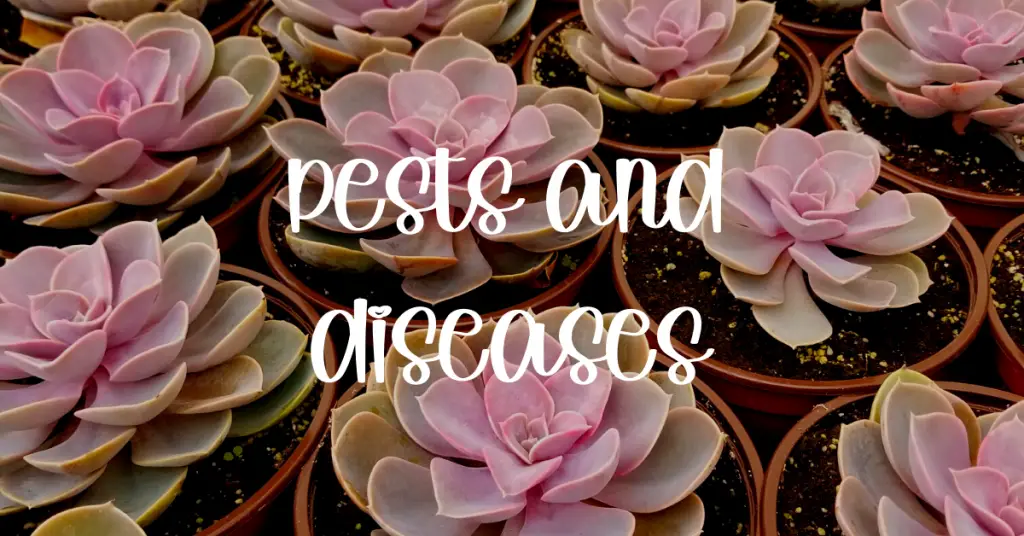
It is important to follow the instructions on these treatments carefully to avoid damage to the plant or the environment. Additionally, beneficial nematodes and predatory insects can be used as natural control measures for some types of pests. Ultimately, the best defense against succulent pests and diseases is prevention through good cultural practices such as proper watering, sanitation, and choosing healthy plants. By using a combination of these control measures, succulent enthusiasts can keep their plants healthy and thriving for years to come.
